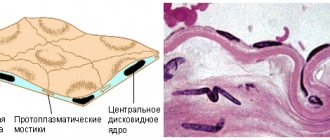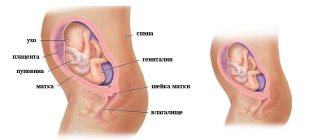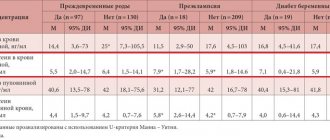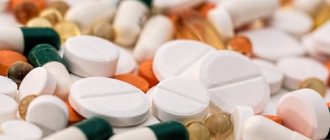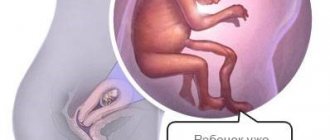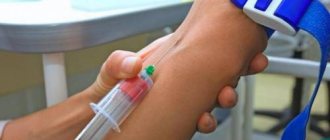10880
During pregnancy, a woman, in addition to ultrasound, general blood tests, urine tests and other important examinations, is recommended to undergo biochemical screening. Biochemistry indicates the health of the patient’s internal organs and metabolism.
An important component of biochemistry is bilirubin, which indicates liver function. Sometimes elevated bilirubin is diagnosed during pregnancy. In this case, a woman carrying a baby requires treatment, since a deviation from the norm signals dysfunction of internal organs and risks for the pregnant woman and baby.
Why may bilirubin be elevated during pregnancy?
Bilirubin may be increased during pregnancy due to the occurrence of liver dysfunction typical for this period. They are directly related to bearing a child, as they appear in previously healthy women. Proven role:
- increased levels of female hormones (especially estrogens), which impair the flow of bile;
- hereditary predisposition (itching and jaundice during pregnancy in mother and sisters);
- bad habits - alcohol, drug addiction, smoking;
- use of toxic medications;
- poor nutrition – fatty, spicy, fried foods.
The main pathologies of the pregnancy period that cause increased indicators:
- early toxicosis with severe vomiting;
- intrahepatic thickening of bile (cholestasis);
- acute fatty degeneration (fatty degeneration) of the liver tissue;
- severe course of late toxicosis (preeclampsia, eclampsia).
Liver damage is possible even before conception. Since the load on all internal organs increases, chronic diseases worsen (for example, hepatitis, including alcoholic, drug-induced, hepatosis, cirrhosis). A viral infection with destruction of liver cells (viral hepatitis, tropical fever, herpes, cytomegalovirus) cannot be ruled out.
Since bilirubin is increased during pregnancy and due to the accelerated destruction of red blood cells, one of the reasons is hemolytic anemia. Disorders of bile pigment metabolism can be provoked by congenital changes in enzyme activity in Gilbert, Rotor, and Dabin-Johnson syndromes.
Jaundice with high bilirubin levels most often occurs in women when the bile duct is blocked by thick bile. Due to hormonal changes, its chemical composition changes, making it difficult to empty the gallbladder, which provokes the formation of stones and sand. Thus, if bilirubin is increased in pregnant women, this means that it is necessary to undergo an examination, since all these diseases are dangerous for the woman and the fetus.
We recommend reading about the normal levels of bilirubin in the blood of women. From the article you will learn about the reasons for the analysis, symptoms of abnormalities, a table of bilirubin norms by age, during pregnancy. And here is more information about how to donate blood for bilirubin - on an empty stomach or not.
What is hyperbilirubinemia
Hyperbilirubinemia in pregnant women is an increase in bilirubin in the blood, that is, detection of levels above 21.6 µmol/l. This condition is accompanied by:
- yellowing of the skin of varying degrees of intensity;
- darkening of urine;
- itchy skin;
- general weakness;
- body aches;
- pain in bones and joints;
- nausea, vomiting;
- heaviness and pain in the abdomen, mainly in the right hypochondrium.
Itchy skin
Is increased bilirubin dangerous in the early stages?
In case of severe toxicosis in the early stages, an increase in bilirubin is most often associated with severe vomiting; it is less dangerous than in the 2-3 trimester. This is explained by the fact that the deterioration of liver function is temporary; nutritional disorders (aversion to food) and dehydration play a role in its development. A slight excess of total, direct and indirect bilirubin is typical.
After toxicosis subsides, nutrition and drinking regime are restored, pigment metabolism returns to normal. Nevertheless, such clinical symptoms are similar to the latent course of viral hepatitis, which causes 50% of cases of increased bilirubin in pregnant women. To identify it, blood tests are performed for specific antigens.
Consequences for mother and baby when increased in later stages
The most dangerous consequences for mother and child are considered to be the consequences of increased bilirubin in the later stages. It is caused by diseases that lead to stillbirth, premature birth, and sometimes causes maternal death. The prognosis can only be improved by early detection and emergency delivery by cesarean section.
The reason for the increase in indicators is late toxicosis (preeclampsia) with deterioration of the kidneys and liver during eclampsia, as well as a deadly form of acute fatty degeneration. The last complication is rare (one case in 13 thousand births), it is characterized by:
- appearance in first-time mothers at 30-38 weeks;
- sudden vomiting with abdominal pain;
- yellowing of the skin;
- elevated body temperature.
Due to extremely rapid progression, renal and liver failure increases, intravascular coagulation develops, and gastrointestinal and uterine bleeding is possible. Moderately elevated levels of bilirubin are found in the blood.
In preeclampsia (severe late toxicosis), liver damage and an increase in bilirubin are caused by vascular disorders. The level of bile pigment found in the blood is 5 times higher than normal (100-120 µmol/l due to direct and bound). Clinical manifestations: swelling, high blood pressure, cramps, nausea, vomiting, abdominal pain.
In the absence of proper treatment, subcapsular hemorrhage and rupture of the liver with extensive internal bleeding are formed. Emergency delivery is indicated.
Watch this video about the complications of eclampsia and preeclampsia:
What to do if bilirubin is high
High bilirubin during pregnancy can be reduced only after finding out the reason for its increase, since the tactics will be completely different depending on the disease. A full examination is prescribed, but before its results it is necessary:
- completely exclude spicy, fatty and fried foods, smoked foods, marinades, canned food, and semi-finished products from the diet;
- introduce boiled, steamed and baked vegetables into the diet - easily digestible vegetables are useful: cauliflower, broccoli, zucchini, pumpkin, carrots, potatoes, green beans;
- cook low-fat meat and fish, avoid frying;
- Every day the menu should include 2-5% cottage cheese and fresh fermented milk drinks without additives;
- drink at least 1.5 liters of water (in case of swelling, the volume is determined depending on urination), replace tea with rosehip decoction, coffee with chicory extract.
Slightly increased bilirubin in the blood during pregnancy can decrease with phototherapy (exposure to ultraviolet rays). The possibility of sun exposure is determined by the doctor.
Preventive actions
To prevent an increase in total bilirubin during pregnancy, you need to be conscious of your condition. This means that you need to try to exclude all factors that can cause pathology.
To prevent increased bilirubin during pregnancy, it is recommended:
- maintain proper nutrition and a healthy lifestyle;
- give up caffeine in favor of purified drinking water;
- control the course of chronic diseases that may worsen during pregnancy;
- do not use medications that are prohibited for pregnant women;
- do not collect or eat wild mushrooms, so as not to cause intoxication of the body;
- register with the antenatal clinic in a timely manner and follow all doctor’s recommendations.
Elevated bilirubin rarely returns to normal on its own. Therefore, at the slightest suspicion of pathology, you should immediately consult a doctor.
Bilirubin in pregnant women: normal
Normally, bilirubin in pregnant women may deviate slightly from the values in women who are not carrying a child (up to 2-3 µmol/l). Acceptable values in the 1st, 2nd and 3rd trimester are shown in the table (measurement units µmol/l).
| Women category | Total bilirubin | Direct bilirubin | Indirect bilirubin |
| Not pregnant | 3,4-19,6 | 0-4,9 | 3,4-13,7 |
| Pregnant | 3,4-21,6 | 0-7,9 | 3,4-14,5 |
| First trimester | 3,4-19,8 | 0-5,2 | 3,4-13,2 |
| Second trimester | 3,4-20,5 | 0-6,5 | 3,4-14,2 |
| Third trimester | 3,4-22 | 0-7,9 | 3,4-14,9 |
| Immediately after birth | 3,4-20,5 | 0-6,9 | 3,4-13,5 |
The laboratory can also use methods for determining bilirubin, which normally give indicators that differ slightly from those given. The range of acceptable values is always indicated on the results form.
Consequences for the expectant mother and fetus
Most often, an increase in bilirubin in the blood occurs in the last trimester of pregnancy. This is due to the enormous load on the liver as a result of an increase in the size of the uterus. In turn, this condition leads to stagnation of bile and increased bilirubin. The consequences for pregnancy can be very different:
- With a slight increase in bile pigment (within 8.4-20.5 µmol/l), there is no danger for mother and child. Bilirubin levels return to normal immediately after childbirth, when the load on the liver is less.
- With a sharp increase in pigment, a real threat arises to the condition of the mother and fetus. If bilirubin levels are not lowered in time, there may be a risk of premature birth or stillbirth. For the mother, a high level of bile pigment may mean the development of hemolytic anemia or hepatitis.
Direct bilirubin during pregnancy
Direct bilirubin during pregnancy increases with liver damage (fatty degeneration, complications of toxicosis, viral hepatitis, cirrhosis, mononucleosis), usually with these diseases the indirect part also increases simultaneously. These pathologies can complicate bearing a child, as they are accompanied by severe intoxication. In acute fatty liver, maternal mortality reaches 80%.
The second reason for high rates is a violation of the outflow of bile inside the liver or in the bile ducts. A good prognosis occurs with minor intrahepatic stagnation and early administration of drugs that improve bilirubin metabolism. If there is a tumor or stone blocking the flow of bile, urgent surgery is necessary.
Total bilirubin during pregnancy
Total bilirubin during pregnancy is increased due to the direct and indirect fractions. The second part is higher than normal usually in hemolytic, including autoimmune, forms of anemia. It leads to insufficient oxygen supply to the fetus, which is dangerous due to disruption of the formation of the child’s brain and internal organs.
A congenital disease associated with a lack of an enzyme (Gilbert's syndrome) has a relatively favorable course. Indirect often increases simultaneously with direct when the liver is damaged, then the danger to mother and child depends entirely on the severity of the underlying disease.
Gilbert's syndrome
What is bilirubin
Bilirubin is a bright yellow bile pigment formed during hemolysis - the destruction of red blood cells - the carriers of hemoglobin.
The lifespan of healthy red cells is 110 days, after which they are transformed into decomposition products: 80% of red blood cells are synthesized by the liver and the rest - outside this gland.
Hemoglobinogenic pigment is synthesized in the liver, spleen and bone marrow, is a hepatic component, and is found in blood and bile. Therefore, with dysfunction of the above organs, the concentration of hemoglobin in the blood changes. If the functioning of the internal organs is disrupted, the color of the stool may change.
Biochemical screening determines three types of bilirubin:
- Indirect (unbound) - appears in free form, does not dissolve in water, is toxic. Prolonged accumulation in the body leads to brain disorders.
- Direct (bound) - soluble in water, formed by the process of binding of indirect bilirubin with glucuronic acid. The remainder of the direct bilirubin is absorbed into the bloodstream and travels with the blood to the kidneys, where it is filtered and excreted in urine. The other part of the bile component is excreted in feces.
- General – the ratio of direct and indirect bilirubin.
If pregnancy proceeds without complications, the levels of direct, indirect and total bilirubin do not deviate from the norm. In the absence of pathologies in a woman preparing to become a mother, bile pigment is not detected.
Diagnosis of the condition
To make a diagnosis in pregnant women, use:
- biochemical blood tests with determination of alkaline phosphatase, transferases (ALT, AST), cholesterol, direct, indirect fraction and total bilirubin;
- urine test for bilirubin and urobilin;
- coagulogram (blood clotting test);
- immunological tests of venous blood for pathogens of infectious hepatitis (PCR, for antigens);
- Ultrasound of the liver and bile ducts, spleen.
Ultrasound
In very rare cases (if it is impossible to determine the disease), pregnant women undergo a liver biopsy.
In what cases can bilirubin levels increase?
Bilirubin in the blood, and then in the urine, increases with certain liver pathologies, and this causes jaundice and darkening of the urine.
There may be several reasons for increased bilirubin in the blood.
For example, the level of direct bilirubin in the blood increases due to a violation of the outflow of bile - it is sent not to the stomach, but to the blood, and the following pathologies can be the reasons for this:
- chronic hepatitis,
- autoimmune hepatitis,
- cholelithiasis,
- viral hepatitis in acute form (hepatitis A, B, infectious mononucleosis),
- bacterial hepatitis (brucellosis, leptospirosis),
- toxic hepatitis (poisoning with industrial toxic substances or mushroom poisons),
- drug-induced hepatitis (as a result of therapy with non-steroidal anti-inflammatory drugs, hormonal drugs, antitumor and anti-tuberculosis drugs),
- biliary cirrhosis,
- Rotor, Dubin-Johnson syndrome,
- cancer of the liver, gallbladder or pancreas.
There may also be several reasons for the increase in indirect bilirubin, and they are most often associated with impaired processing of indirect bilirubin or with the accelerated breakdown of red blood cells. However, since indirect bilirubin does not dissolve in water, even if it is significantly increased in the blood, no abnormalities will be found in a urine test.
And the reasons causing an increase in indirect bilirubin may be as follows:
- congenital hemolytic anemia,
- secondary hemolytic anemia (against the background of certain diseases such as lymphogranulomatosis, lymphocytic leukemia, rheumatoid arthritis, etc.),
- drug-induced hemolytic anemia, which is associated with taking certain drugs (for example, aspirin, insulin, chloramphenicol, etc.),
- toxic hemolytic anemia (snake bites, insect bites, poisoning by mushrooms, harmful substances - copper salts, lead, etc.),
- infectious diseases (such as malaria, sepsis, typhoid fever),
- syndromes of Gilbert, Lucy-Driscol, Crigler-Najjar.
Increased bilirubin in urine occurs in diseases that are accompanied by damage to liver cells:
- hepatitis,
- liver injuries,
- liver cirrhosis,
- metastatic liver damage, etc.
Preventing Value Changes
In order to reduce the risk of liver disease, which is accompanied by an increase in bilirubin in the blood, it is important for pregnant women to:
- good nutrition with regular meals (hourly) in fractional quantities 5-6 times a day;
- avoid overeating and long breaks in meals;
- give up alcohol, smoking, coffee and strong tea;
- take into account the risk factors for viral hepatitis - cosmetic manipulations that damage the skin are prohibited (for example, trimmed manicure in a salon, ear piercing);
- do not use medications without a doctor’s prescription (tetracycline is one of the likely causes of acute liver dystrophy in a pregnant woman);
- regularly visit a gynecologist and undergo all prescribed examinations;
- spend at least an hour in the fresh air every day, walk as much as possible, but avoid overwork;
- do not ignore the symptoms of toxicosis (vomiting, loss of appetite); in case of any severe discomfort, immediately consult a doctor.
We recommend reading about the diet for high bilirubin. From the article you will learn about the principles of a diet with high bilirubin for women and men, during pregnancy, foods that increase and decrease bilirubin levels. And here is more information about how bilirubin is exchanged in the body.
An increase in bilirubin in pregnant women may be associated with stagnation of bile, toxicosis, chronic liver diseases, and destruction of red blood cells. An increase in indicators can be dangerous in case of acute fatty degeneration and the development of liver failure. Small deviations from the norm can be eliminated with diet and IVs; less often, urgent surgery is necessary.
Content:
- What is bilirubin?
- Total bilirubin in pregnant women: norm and deviations
- Causes of elevated bilirubin
- What to do with increased bilirubin
← Proper nutrition for high levels of bilirubin in the blood
What to do if the level of basophils increases and what could this mean? →
Throughout pregnancy, the expectant mother regularly undergoes laboratory tests that allow her to monitor the progress of pregnancy. One of the important indicators of blood tests, which doctors pay special attention to, is bilirubin. As a rule, the amount of bilirubin in the blood increases slightly during pregnancy, which is considered normal. If the amount of bilirubin exceeds the norm, the expectant mother requires a thorough examination, since such indicators can be dangerous for both the woman and the fetus.
Important! During gestation, bilirubin in pregnant women may be slightly elevated and is not considered a pathology by the doctor. Its quantity can increase along with the growth of the fetus, while the level of increase is insignificant and practically imperceptible in the transcript of the analysis.
Norm and deviations
Since bilirubin is directly related to bile and liver, the answer to the question of its increase should be sought in these two directions. During pregnancy, there is a need to control bilirubin levels. For him, norms of a certain level are assumed, which apply specifically to girls who are in the process of pregnancy. The indicator should fit within the range from 8.5 to 20.5 mmol/l.
If deviations from the norm are present, for example, an increase, you may encounter jaundice. In most cases, in the absence of any chronic disease, the norm of bilirubin during pregnancy should remain within the limits specified above. However, there are reasons why changes in indicators in both directions are recorded.
If the pigment differs from the normal value, a more detailed study is recommended, since increased bilirubin affects the health of a child who has not yet fully formed. In addition, such an indicator may be a sign of various diseases, the consequences of which include the risk of childbirth before the planned date or stillbirth. To prevent such serious consequences, it is important to carry out the tests prescribed by your doctor on time.


